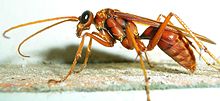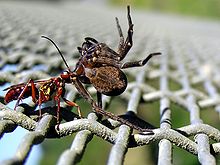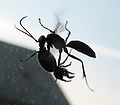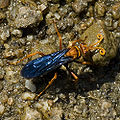- Spider wasp
-
Spider wasps 
Scientific classification Kingdom: Animalia Phylum: Arthropoda Class: Insecta Order: Hymenoptera Suborder: Apocrita Superfamily: Vespoidea Family: Pompilidae Subfamilies Ceropalinae
Ctenocerinae
Pepsinae
PompilinaeWasps in the family Pompilidae are commonly called spider wasps (in South America, species may be referred to colloquially as marabunta or marimbondo, though these names can be generally applied to any very large stinging wasps). The family is cosmopolitan, with some 4,200 species in 4 subfamilies.[1] All species are solitary, and most capture and paralyze prey, though members of the subfamily Ceropalinae are cleptoparasites of other pompilids, or ectoparasitoids of living spiders.[2]
Spider wasps are best distinguished from other vespoid wasps in having (in most species) a transverse groove dividing the mesopleuron (the mesepisternal sclerite, a region on the side of middle segment of the thorax above the point where the legs join) into halves. Like other Vespoidea they have antennae with 10 flagellomeres in the female and 11 in the male. Most Pompilidae have the inner margin of the eye straight. The hind wings do not have a distinct claval lobe but they have a distinctive jugal lobe. The hind leg has a tibial spur with a tuft or row of fine hairs. The legs are long and slender with the tips of the tibia (metatibia) long enough to extend beyond the tip of the abdomen (metasoma). Sexual dimorphism is not marked although females are often larger than the males, with coloring and wing appearance varying greatly among the many species, though black is the most common color, with contrasting aposematic markings of orange, red, yellow, or white also being fairly common.[2] Larvae can also be identified by physical examination.
Spider wasps are long-legged, solitary wasps that use a single spider as a host for feeding their larvae. They paralyze the spider with a venomous stinger. Once paralyzed, the spider is dragged to where a nest will be built – some wasps having already made a nest.[3]
A single egg is laid on the abdomen of the spider, and the nest – or burrow – is closed.
The size of the host can influence whether the wasp will lay an egg that will develop as a male, or an egg that will develop into a female – larger prey yielding the (larger) females.[4] A complex set of adult behavior can then occur, such as spreading dirt or inspecting the area, leaving the nest site inconspicuous. When the wasp larva hatches it begins to feed on the still-living spider. After consuming the edible parts of the spider, the larva spins a silk cocoon and pupates – usually emerging as an adult the next summer. Some ceropalines lay the egg on a still-active spider, where it feeds externally on hemolymph. In time, that spider will die, and the mature wasp larva will then pupate.
Video of spider wasp with prey (23s)
-
Unidentified species of spider wasp hunting in Texas, United States
-
Spider wasp with its prey near Heemstede, The Netherlands
-
A pompilid from Bangalore
See also
References
- ^ Pitts, James P.;Wasbauer MS & von Dohlen CD (2005). "Preliminary morphological analysis of relationships between the spider wasp subfamilies (Hymenoptera: Pompilidae): revisiting an old problem". Zoologica Scripta 35 (1): 63–84. doi:10.1111/j.1463-6409.2005.00217.x.
- ^ a b Goulet, H & Huber, JT, ed (1993). Hymenoptera of the world: an identification guide to families. Agriculture Canada. pp. 202–205.
- ^ Spider Wasps Australian Museum Online
- ^ Spider predators and parasites. Iziko Museums of Cape Town. www.museums.org.za. Retrieved 28 November 2006.
External links
Categories:- Pompilidae
Wikimedia Foundation. 2010.











